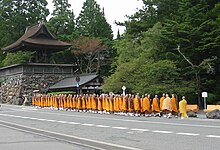Angya

Angya (行脚[1]) is a term used in Zen Buddhism in reference to the traditional pilgrimage a monk or nun makes from monastery to monastery, literally translated as "to go on foot."[2] The term also applies to the modern practice in Japan of an unsui (novice monk) journeying to seek admittance into a monastery for the first time. These unsui traditionally wear and/or carry a kasa, white cotton leggings, straw sandals, a kesa, a satchel, razor, begging bowls (hachi) and straw raincoat.[3] When arriving the novice typically proffers an introductory letter and then must wait for acceptance for a period of days called tangaryō. Upon admittance he undergoes a probationary period known as .[2][3] Considered an aspect of the early monk's training, angya had in ancient times lasted for many years for some. For instance, Bankei Yōtaku undertook a four-year angya upon leaving Zuiō-ji in 1641.[4]
See also[]
Notes[]
- ^ Kenkyusha's New Japanese-English Dictionary, Kenkyusha Limited, ISBN 4-7674-2015-6
- ^ Jump up to: a b Baroni, 8-9
- ^ Jump up to: a b Wood, 4
- ^ Hakeda, et al.; xxiv-xxv
References[]
- (2002). The Illustrated Encyclopedia of Zen Buddhism. The Rosen Publishing Group, Inc. ISBN 0-8239-2240-5.
- Hakeda, Yoshito S.; Bankei; Haskel, Peter (1994). Bankei Zen: Translations from the Record of Bankei. Grove Press. ISBN 0-8021-3184-0.
- Wood, Ernest (2001). The Dictionary of Zen. Citadel Press. ISBN 0-8065-2291-7.
- Zen
- Zen stubs